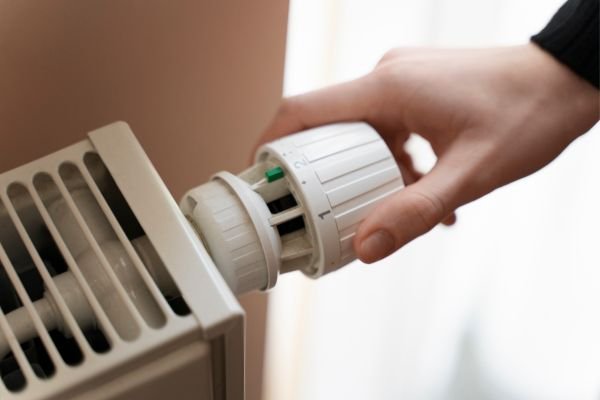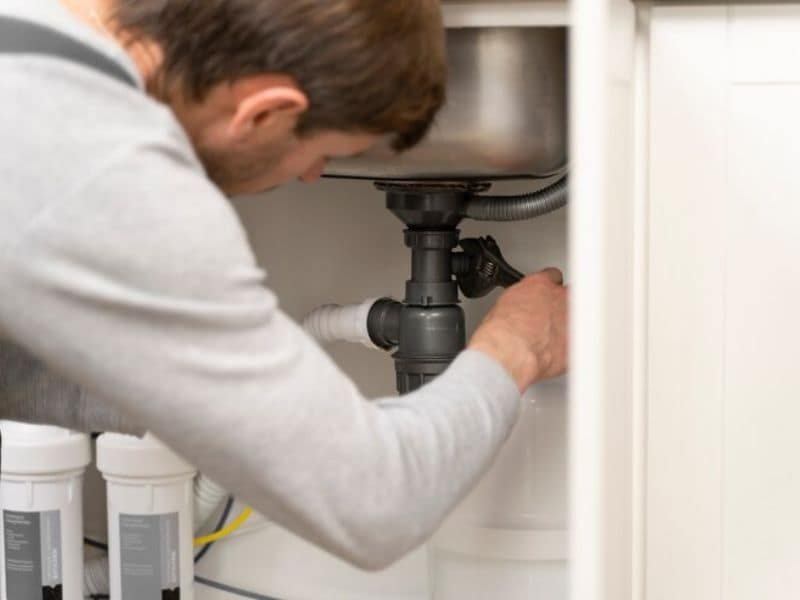Your water heater quietly works day and night to deliver hot water for showers, dishes, and laundry but if the temperature isn’t set right, it can cause more problems than you might think.
- Too hot, and you risk scalding burns and higher energy bills.
- Too cold, and you might end up with lukewarm showers or ineffective cleaning.
Adjusting the water heater temperature is a quick, low-cost way to improve comfort, protect your plumbing, and save money. Good news? You can do it yourself in less than 15 minutes with less basic tools.

Recommended Temperature Settings
Finding the right balance is key. Experts generally recommend keeping your water heater at 120°F (49°C) but there are exceptions.
The Safety Sweet Spot: 120°F (49°C)
This is the U.S. Department of Energy’s recommended setting because it:
- Prevents scalding accidents, especially for children and elderly family members.
- Saves on energy bills by reducing standby heat loss.
- Minimizes mineral buildup and corrosion inside the tank.
When You Might Want It Higher
You could increase it to 130–140°F if:
- You have a compromised immune system and want extra protection against bacteria like Legionella.
- Your dishwasher doesn’t have a built-in heating element.
- You prefer hotter showers or have a large household with high demand.
When You Might Want It Lower
You might lower it slightly if:
- You have small children or elderly family members prone to burns.
- Your household uses very little hot water, and you want maximum energy savings.
- You live in a warm climate where water naturally warms in the pipes.
READ MORE: How to Clean a Hot Water Heater
Safety Precautions Before You Begin
Before making adjustments, safety comes first. Water heaters deal with high temperatures, electricity, and gas so caution is critical.
Turn Off Power or Gas
- For electric models: Flip the circuit breaker labeled “water heater” to the OFF position.
- For gas models: Turn the thermostat control to the “Pilot” setting to prevent the burner from firing.
Let the Tank Cool Down
Hot water can cause severe burns in seconds. Give the tank at least an hour to cool if it’s been in use.
Wear Protective Gear
- Gloves to protect against sharp edges or hot surfaces.
- Safety glasses to guard against splashes.
- Closed-toe shoes in case of spills.
How to Adjust Temperature on an Electric Water Heater
Electric water heaters use thermostats hidden behind access panels, usually two, one for the upper element and one for the lower.
Tools You’ll Need
- Flathead screwdriver
- Non-contact voltage tester (optional but recommended)
- Work gloves
Step-by-Step Process
- Shut Off Power at the breaker panel.
- Remove the Access Panels on the side of the tank.
- Peel Back Insulation to reveal the thermostat.
- Check for Power using a voltage tester to ensure it’s safe to touch.
- Turn the Screw on the Thermostat Dial clockwise for hotter, counterclockwise for cooler.
- Repeat for Lower Thermostat if applicable (matching the upper setting is best).
- Replace Insulation and Panels before restoring power.
Testing the New Temperature
After adjusting, wait a few hours and test water from the nearest faucet using a kitchen thermometer. Fine tune if needed.
How to Adjust Temperature on a Gas Water Heater
Gas models are usually easier; most have a clearly marked dial near the bottom.
Locating the Temperature Dial
Look for a knob or dial labeled “Warm,” “Hot,” and sometimes with actual temperature numbers.
Adjusting the Setting
- Turn slightly toward “Hot” to raise temperature.
- Turn toward “Warm” to lower.
Small changes make a big difference and adjust in small increments.
READ MORE: How to Remove Sulfur Smell from Hot Water Heater
Safety Tips for Gas Models
- Always keep the area around the heater free of flammable materials.
- Avoid turning the setting above 140°F to prevent scalding.
- Relight the pilot according to the manufacturer’s instructions if it goes out.
How to Adjust Temperature on a Tankless Water Heater
Tankless water heaters are even more straightforward than tank-style models. Since they heat water on demand, the temperature adjustment process is usually digital.
Using the Control Panel
Most modern tankless models come with an electronic display panel.
- Locate the Display: Usually mounted on the unit or wall nearby.
- Press the Temperature Button: Use the arrow keys to increase or decrease the temperature.
- Set to the Desired Temperature: Commonly between 115°F and 125°F for daily use.
- Confirm and Save: Some units require pressing “Set” or “OK” to lock in changes.
Advantages of Tankless Temperature Adjustment
- Precise Control: Adjust to the exact degree.
- Instant Results: No waiting hours for a tank to heat up.
- Energy Efficiency: Lower settings immediately save energy.
Testing the Water After Adjustment
Regardless of the water heater type, testing ensures you’ve hit the sweet spot.
Method
- Turn on a hot water tap closest to the heater.
- Let it run for at least 3 minutes.
- Fill a glass and measure with a kitchen thermometer.
Adjust if Needed
- If it’s too cool, increase by 5°F.
- If it’s too hot, decrease by 5°F.
Always wait a couple of hours after adjustments to re-test for tank models.
Energy Efficiency Benefits of Correct Settings
Water heating accounts for 14–18% of your utility bill. Optimizing the temperature reduces waste and keeps costs down.
- 120°F Setting: Saves about $30–$60 per year compared to 140°F.
- Lower Maintenance Costs: Less heat reduces mineral scale buildup.
- Extended Appliance Lifespan: Reduces stress on heater components.
Common Problems After Adjusting Temperature
If your water heater acts strangely after changes, here’s what might be happening:
- Water Still Feels Cold: The thermostat may be faulty or the heating element burned out.
- Water Too Hot: Setting may be too high or the thermostat stuck.
- Fluctuating Temperatures: Sediment buildup or failing parts could be causing inconsistent heating.
When to Call a Professional
While temperature adjustment is a simple DIY task, you should call a plumber if:
- The heater doesn’t respond to changes.
- You see signs of leaks or corrosion.
- There’s a strong gas smell (for gas models).
- You’re uncomfortable handling electricity or gas lines.
Conclusion
Adjusting the temperature on your water heater is a quick, cost-free way to rest, safety and improve efficiency. Whether you have an electric, gas, or tankless unit, the process takes only a few minutes and can prevent your energy bills from burning. Just remember to make small changes, test with a thermometer and prioritize safety.
FAQs
1. What’s the safest temperature for a water heater?
120 ° F is generally considered safe for most homes.
2. Can I save money by lowering my water heater temperature?
Yes, lowering it by 10°F can save 3–5% on water heating costs.
3. How often should I check my water heater temperature?
At least once a year, or if you notice temperature changes.
4. Can setting my water heater too low cause problems?
Yes, water below 120°F may encourage bacterial growth like Legionella.
5. Do I need special tools to adjust my water heater?
Usually just a screwdriver for tank models or your fingers for gas/tankless dials.

